
© Elena Fetisova. (Click image for larger version)
The Bolshoi Ballet
Giselle
Washington, Kennedy Center Opera House
May 20, 2014
www.bolshoi.ru
www.kennedy-center.org
Giselle is a ballerina’s ballet – that is, unless an Albrecht of exceptional dramatic artistry and charisma makes it his own story of love, loss and grief, as happened during the opening night performance of the Bolshoi Ballet at the Kennedy Center Opera House, when David Hallberg and Svetlana Zakharova took center stage as the leads in Yuri Grigorovich’s re-make of this Romantic classic.
David Hallberg is a rarity in today’s classical ballet. Tall, lean and strikingly handsome, with pure classical line and impeccable dancing prowess, he is a genuine danseur noble. He has been a principal dancer of American Ballet Theatre since 2006. In 2011, Hallberg made history by joining the principal ranks of the Bolshoi Ballet – the first American dancer ever to do so. The opening night performance of Giselle at the Kennedy Center was his American debut as a member of Russia’s famous company.
With his magnetic stage presence and compelling acting, Hallberg delivered a poignant portrayal of Albrecht. The tragedy of his hero, his moral downfall, his penance and ultimate suffering formed the emotional core of this performance. He completely immersed himself in the role, emerging as a true Romantic hero.
His impetuous Albrecht grabbed the audience’s attention from his first entrance in Act I, when, after hiding his sword, he gently knocked on the door of Giselle’s house, his face beaming with utter excitement. He was eager to see his new love interest and could hardly contain his happiness.
From that first moment Hallberg established a perfectly believable rapport with the title heroine (Svetlana Zakharova). Their chemistry was so undeniable, natural and intense that they seemed to be destined for each other.
This Albrecht was unconditionally smitten by Zakharova’s Giselle – a lovely young peasant girl with an innocent but weak heart. He was completely intoxicated by love, and when he looked at her, he did so with utmost tenderness and adoration, entirely losing himself in his newly- discovered feeling.

© Elena Fetisova. (Click image for larger version)
As Giselle, the tall and willowy Zakharova – the Bolshoi’s most prominent prima ballerina – was sweetly naive and charming, but hardly the fragile, sickly creature called for in the storyline. In the first act, ignoring her mother’s warnings, she briskly skipped and hopped about the stage without a trace of frailty or vulnerability. Zakharova’s dancing was wonderfully spacious and musical, yet hers was a modern take on a Romantic style, with an attack, authority and exactitude more suitable for a Balanchine ballet.
When she learned that her fiancé is not a villager but an imposter – a count, disguised as a commoner, and engaged to be married to another woman – she slipped into a deep trance, moving absentmindedly as if hallucinating. Her mad scene was ephemeral and never touched the heart. Instead, all the drama was rendered by Hallberg, who looked so grief-stricken and shocked it was devastating to watch.
In most productions, after Giselle dies, Albrecht flees the village. In the Bolshoi’s staging, he remains at the scene, holding Giselle’s lifeless body, surrounded by the mournful crowd of townspeople. This final moment was frozen in time and space as the dancers remained motionless as if in a frieze.
The first act’s ensembles of merry villagers offered a glimpse of the Bolshoi’s traditional bravura style. The dancers of the corps went through repetitive motions, prancing in unison and clapping their hands; yet for all their enthusiasm, the stage was too busy and the choreography itself looked rather routine and short on excitement. Daria Khokhlova and Igor Tsvirko seemed too timid and unseasoned to bring any spark in the Peasant Pas de Deux.
The second act unfurled in the mystical moonlit forest populated by the vindictive wilis – spirits of young maidens betrayed in love and dead before their wedding day. Reincarnated as a ghost, Zakharova reined onstage, dancing with subliminal elegance and delicacy. One could only marvel at the beauty of her silhouette stretched in a deep arabesque, the supreme expressiveness of her willowy arms and the speed and spaciousness of her graceful leaps. A frenzied whirl at the beginning of her entrance was simply breathtaking. She was a poignant creature, merciful and strong-willed at the same time, shielding and ultimately rescuing her beloved from imminent death.
In this production Albrecht has one of the longest promenades to Giselle’s grave in memory, accompanied by Adolphe Adam’s lachrymose music; and Hallberg, in his sorrowful walk across the entire stage, was the embodiment of everlasting grief. His near-fateful encounter with the wilis was one of the most thrilling moments of the ballet as he took to the air, at the command of Myrtha, Queen of the Wilis, executing a series of high-flying jumps. Hallberg perfectly rendered his hero’s growing emotional pain and physical exhaustion.
Vitaly Biktimirov gave a rather unusual reading of the rejected Hans, the village’s gamekeeper, portraying him as an overly-protective older brother rather than a man deeply in love. He was appropriately hateful towards Albrecht, but showed no sign of romantic love for Giselle.
Maria Allash was the menacing Myrtha; and the female corps de ballet was in a fine form, dancing with unity and style as they formed and dissolved their deadly circles and diagonals.
This staging is a revival of the 1987 version of Giselle by the Bolshoi’s long-standing choreographer Yuri Grigorovich, who, at 87, is one of the oldest working choreographers today and Russia’s most celebrated and revered ballet master. The Grigorovich era at the Bolshoi Ballet has spanned a half century and his phenomenon is explained by the huge mass appeal and commercial viability of his ballets in Russia.
This production is a fairly traditional take on Giselle, based on the original choreography by Jean Coralli, Jules Perrot and Marius Petipa, with a streamlined storyline and reduced pantomime, often at the expense of dramatic logic; and a greater emphasis on pure dancing. It’s a solid production but still a far cry from some of the best productions of Giselle (by the Mariinsky Ballet and Paris Opera Ballet) Washington audiences have enjoyed in the past few years.









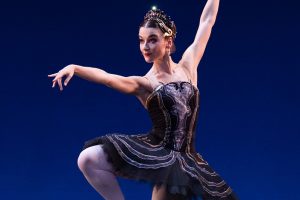

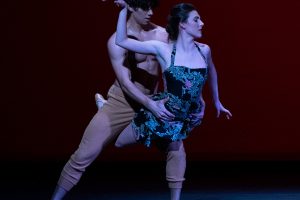

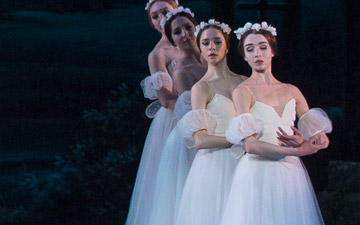
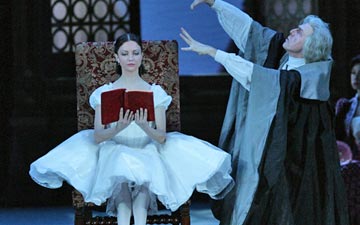

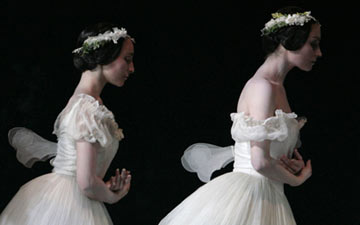
I can see it all! I still remember Hallberg from his first Giselle with Cojocaru at ABT, which left me stunned.
Oh, did Oksana’s post ever bring back memories of two memorable pas de deux
from Act II of Giselle; Rudolf Nureyev and Margot Fonteyn in the Royal Ballet
production when they first appeared in San Francisco and Mikhail Lavrovsky with Evelyn Hart at Arizona State University in Phoenix in the mid ’80’s.
What they did was to make Giselle a figment of their imagination in Act II, the
benevolent feminine – the anima of Jungian psychology – and it sounds very much
as if Hallberg is the third such interpreter. Marvelous.
And Oksana, wonderful perspective!